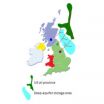Led by Arthur Shapiro of American University and Zhong-Lin Lu of the University of Southern California, the researchers explain the illusion of the curveball's break in a publicly available study in the journal PLoS ONE (study available by request or post-embargo at http://dx.plos.org/10.1371/journal.pone.0013296).
The study comes a year after the same group won the prize for best illusion at the Vision Sciences annual meeting with a demonstration of how an object falling in a straight line can seem to change direction (http://illusioncontest.neuralcorrelate.com/2009/the-break-of-the-curveball/).
That demonstration led to debates among baseball fans over the existence of the break in curveballs, breaking balls and sliders.
There is no debate in the researchers' minds.
"The curveball does curve, but the curve has been measured and shown to be gradual," Shapiro said. "It's always going to follow a parabolic path. But from a hitter's point of view, an approaching ball can appear to break, drop or do a whole range of unusual behaviors."
A little terminology: to many batters and pitchers, a break is a deviation from the relatively straight path of a fastball. In that sense, all curveballs break.
The authors of the study use the term to describe an apparent sudden drop or other change in trajectory as the ball nears home plate. That, they say, is an illusion.
The PLoS ONE study explains the illusion and relates the perceived size of the break to the shifting of the batter's eye between central and peripheral vision.
"If the batter takes his eye off the ball by 10 degrees, the size of the break is about one foot," Lu said.
He explained that batters tend to switch from central to peripheral vision when the ball is about 20 feet away, or two-thirds of the way to home plate. The eye's peripheral vision lacks the ability to separate the motions of the spinning ball, Lu said. In particular, it gets confused by the combination of the ball's velocity and spin.
The result is a gap between the ball's trajectory and the path as perceived by the batter. The gap is small when the batter switches to peripheral vision, but gets larger as the ball travels the last 20 feet to home plate.
As the ball arrives at the plate, the batter switches back to central vision and sees it in a different spot than expected. That perception of an abrupt change is the "break" in the curveball that frustrates batters.
"Depending on how much and when the batter's eyes shift while tracking the ball, you can actually get a sizable break," Lu said. "The difference between central and peripheral vision is key to understanding the break of the curveball."
A similar illusion explains the "rising fastball," Lu added.
The obvious remedy for a batter, repeated by parents and coaches everywhere, is to "keep your eye on the ball."
That is easier said than done, according to the authors. As the ball nears home plate, its size in the batter's field of view spills out of the eye's central vision.
"Our central vision is very small," Shapiro said. "It's the size of the tip of your thumb at arm's length. When an object falls outside of that region, strange perceptions can occur."
Lu noted that the spin of the ball tends to draw the eye to the side, making it even harder for the batter to keep the ball in central vision.
"People's eyes have a natural tendency to follow motion," Lu explained.
His advice to hitters: "Don't trust your eyes. Know the limitations of your visual system. This is something that can be trained, probably."
Lu, Shapiro and their co-authors plan to build a physical device to test the curveball illusion. Their study was carried out with volunteers tracking the movement of a disk on a computer monitor.
To the authors' knowledge, the PLoS ONE study represents the first attempt to explain the break in the curveball purely as a visual illusion. Others have tried to explain the break as a result of the hitter overestimating the speed of a pitch.
Responding to comments from baseball fans, Lu agreed that on television, pitches filmed from behind home plate appear to break. He called it a "geometric illusion" based on the fact that for the first part of a pitch, the viewer sees little or no vertical drop.
The ball is falling at the same rate throughout the pitch, Lu said, but because the pitcher tosses the ball at a slight upward angle, the first part of the pitch appears more or less flat.
As a result, the drop of the ball near home plate surprises the eye.
For Shapiro and Lu, who have studied visual perception for many years, the PLoS ONE results go beyond baseball.
"Humans constantly shift objects between central and peripheral vision and may encounter effects like the curveball's break regularly," the authors wrote. "Peripheral vision's inability to separate different visual signals may have f ar-reaching implications in understanding human visual perception and functional vision in daily life."
HOW THE EXPERIMENT WAS CONDUCTED:
The visual stimulus consisted of a descending disk (to represent global motion, or the ball's path through space) with an internal moving
grating (representing local motion, or the spin on the ball). When the five observers viewed the disk centrally, they perceived both
global and local motion (i.e., observers saw the disk's vertical descent and the
internal spinning). When observers viewed the disk peripherally, the internal portion
appeared stationary, and the disk appeared to descend at an angle. The angle of
perceived descent increased as the observer viewed the stimulus from further in the
periphery.
The researchers estimated the magnitude of the illusion by
measuring the physical angle of descent that created the perception of vertical descent. The experimenter adjusted the physical angle of descent, and the observer
reported whether he/she perceived the disk to fall vertically. For example, the experimenter
adjusted the global motion direction of the disk 20 degrees to the right if the observer
reported, “No. The disk is moving to the left about 20 degrees.” The amount of adjustment
became smaller as the observer reported that he/she saw the disk falling closer to vertical.
The stimulus was on until the observer made a response, in response to which the
experimenter changed the physical direction of the descending disk. An observer’s response was measured twice.
There were twenty-four different conditions based on every combination of the following: three eccentricities (0, 15 and 30
degrees), two directions for the internal grating (0 and 180 degrees), and four moving speeds
(6.7, 10, 13.3 and 20 deg/sec). Each condition was repeated four times. Observers practiced
two trials for each condition before data collection.
###Lu, a professor of psychology and biomedical engineering at USC, holds the William M. Keck Chair in Cognitive Neuroscience. In addition to first author Shapiro, the co-authors were Chang-Bing Huang of USC, Emily Knight of the Mayo Clinic and Robert Ennis of the SUNY College of Optometry.
To read a LiveScience interview with Lu from last year, go to http://www.livescience.com/culture/091102-sl-lu.html
The research was partially supported by the National Eye Institute.
END



